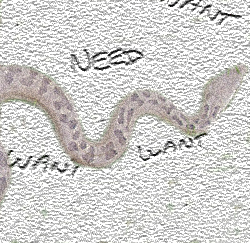West Indian herpetofauna in vivaria West Indian reptiles and amphibians are fascinating animals to keep due to their interesting appearance and the behaviors they display. Many species are small to medium sized and can therefore be kept by zoos and private keepers alike. Due to the slender stature of most species, West Indian boas are fascinating faunistic gems in naturalistic decorated vivaria equipped with living plants.
Keeping West Indian Reptiles and Amphibians has a long tradition among herpetoculturists and many species have been regular guests in the collections of private keepers and zoos since the 1800’s (e.g. Chilabothrus striatus being kept by him). This trend was propelled by the facilitation of airplane travel, which enabled private collectors to easily reach islands of the West Indies and bring safely back many herpetological treasures.
At the same time, important academic research was performed on the regions herpetofauna. During the 1970’s, 1980’s and 1990’s wild caught, as well as captive bred, West Indian boas would regularly appear on the price lists of reptile dealers in North America and Europe – many of which were located in Florida.
Vivaristic history of West Indian boas Pricelist Herptarium 1972
Pricelist from the Herptarium from 1972
Pricelist Pet Farm 1985
Pricelist from the Pet Farm from 1985
Pricelist The Shed 1978
Pricelist from The Shed from 1978
Pricelist Tom Crutchfield
Pricelist from Tom Crutchfield´s 1994
Pricelist The Shed 1983
Pricelist from The Shed from 1983
Emil Reichelt's price list
German Animal Dealer Emil Reichelt's pricelist from 1907 showed several West Indian Boas. Many thanks to Andreas Brahm and Gerold Schipper of https://www.chimaira.de/
Picelist from Hogtown Herpetological Supply, 1992
Pricelist from Herpetofauna, 1980
More details about the history of reptile husbandry and developments in the amateur as well as professional sector can be found in the articles by Murphy and McCloud
It was during this time that several zoos, institutes and private breeders wrote herpetological history by breeding and raising many of the West Indian boa species for the first time e.g.
Luckily, many of the species can grow very old (as described in the different species accounts under the point Longevity ) when resting in capable hands, therefore some methusaic specimens are still present in collections and in some cases represent the only ambassadors for their species outside their natural habitats. Several other West Indian boa species, subspecies or color forms have vanished from private or zoo collections for good. In the last decade, we saw an renaissance of interest in these boas and we are lucky enough that still many species and subspecies are hidden in collections all over the world.
The future of West Indian boas in herpetoculture and nature At the time of this writing, several species of West Indian boas and Tropidophis species are kept in the collections of Zoos and private keepers worldwide. This is important for several reasons:
Captive specimens of reptiles and amphibians contributed tremendously to our knowledge about these globally endangered animal classes. It is due to animal keeping that we know about size and weight, longevity, behavior, diet, mating behavior, clutch and litter sizes, offspring sizes, ontogenetic changes, and many more biological aspects. This knowledge is extremely valuable to develop protection strategies in the wild and advise captive breeding strategies for the survival of threatened species. The exchange of knowledge between academic scientists, zoos and private keepers and breeders is of crucial importance for the protection of species, both in the wild as well as in captive populations. Last but not least, captive populations function as a genetic backup for wild populations which are extremely vulnerable in times of man made climate change, rising sea levels, pollution and habitat loss. We are aiming at a large, diverse and self reproducing ex-situ population of West Indian boas and strongly encourage private keepers, academic research, and public collections to combine their efforts to achieve this goal. Continue to Requirements for keeping West Indian Boas Citations
{2129430:E3BWWHFH};{2129430:QQM9K6QS};{2129430:IGTXZ4MC},{2129430:LT9W8RJ3};{2129430:MV2RNZ7N},{2129430:ZMAAXTX6},{2129430:U6HP62V7},{2129430:2L5CYZ4I},{2129430:CBAKCHZN},{2129430:GD8RDCVY},{2129430:YBGNCDFD}
apa
author
asc
no
398 %7B%22status%22%3A%22success%22%2C%22updateneeded%22%3Afalse%2C%22instance%22%3A%22zotpress-69b88fcb3bfc7ca13a0dcfcaa2c30aa1%22%2C%22meta%22%3A%7B%22request_last%22%3A0%2C%22request_next%22%3A0%2C%22used_cache%22%3Atrue%7D%2C%22data%22%3A%5B%7B%22key%22%3A%22QQM9K6QS%22%2C%22library%22%3A%7B%22id%22%3A2129430%7D%2C%22meta%22%3A%7B%22creatorSummary%22%3A%22Brehm%22%2C%22parsedDate%22%3A%221878%22%2C%22numChildren%22%3A2%7D%2C%22bib%22%3A%22%3Cdiv%20class%3D%5C%22csl-bib-body%5C%22%20style%3D%5C%22line-height%3A%202%3B%20padding-left%3A%201em%3B%20text-indent%3A-1em%3B%5C%22%3E%5Cn%20%20%3Cdiv%20class%3D%5C%22csl-entry%5C%22%3EBrehm%2C%20A.%20E.%20%281878%29.%20%3Ci%3EBrehms%20thierleben%2C%20allgemeine%20kunde%20des%20thierreichs.%20Abt.3%3ABd.1%3A%20Vol.%20Abt.3%3ABd.1%20%281878%29%3C%5C%2Fi%3E%20%282.%20umgearb%20und%20verm%20Aufl.%29.%20Verlag%20des%20Bibliographischen%20instituts%2C.%20%3Ca%20href%3D%27https%3A%5C%2F%5C%2Fwww.biodiversitylibrary.org%5C%2Fitem%5C%2F15728%27%3Ehttps%3A%5C%2F%5C%2Fwww.biodiversitylibrary.org%5C%2Fitem%5C%2F15728%3C%5C%2Fa%3E%3C%5C%2Fdiv%3E%5Cn%3C%5C%2Fdiv%3E%22%2C%22data%22%3A%7B%22itemType%22%3A%22book%22%2C%22title%22%3A%22Brehms%20thierleben%2C%20allgemeine%20kunde%20des%20thierreichs.%20Abt.3%3ABd.1%22%2C%22creators%22%3A%5B%7B%22creatorType%22%3A%22author%22%2C%22firstName%22%3A%22Alfred%20Edmund%2C%22%2C%22lastName%22%3A%22Brehm%22%7D%5D%2C%22abstractNote%22%3A%22%22%2C%22date%22%3A%221878%22%2C%22language%22%3A%22%22%2C%22ISBN%22%3A%22%22%2C%22url%22%3A%22https%3A%5C%2F%5C%2Fwww.biodiversitylibrary.org%5C%2Fitem%5C%2F15728%22%2C%22collections%22%3A%5B%224E2FHAKS%22%5D%2C%22dateModified%22%3A%222020-12-14T23%3A41%3A33Z%22%7D%7D%2C%7B%22key%22%3A%22U6HP62V7%22%2C%22library%22%3A%7B%22id%22%3A2129430%7D%2C%22meta%22%3A%7B%22creatorSummary%22%3A%22Bulian%22%2C%22parsedDate%22%3A%221987%22%2C%22numChildren%22%3A1%7D%2C%22bib%22%3A%22%3Cdiv%20class%3D%5C%22csl-bib-body%5C%22%20style%3D%5C%22line-height%3A%202%3B%20padding-left%3A%201em%3B%20text-indent%3A-1em%3B%5C%22%3E%5Cn%20%20%3Cdiv%20class%3D%5C%22csl-entry%5C%22%3EBulian%2C%20J.%20%281987%29.%20Epicrates%20fordii%20-%20eine%20Riesenschlange%20f%26%23xFC%3Br%20kleine%20Terrarien.%20%3Ci%3EHerpetofauna%3C%5C%2Fi%3E%2C%20%3Ci%3E9%3C%5C%2Fi%3E%2848%29%2C%2014%26%23x2013%3B17.%3C%5C%2Fdiv%3E%5Cn%3C%5C%2Fdiv%3E%22%2C%22data%22%3A%7B%22itemType%22%3A%22journalArticle%22%2C%22title%22%3A%22Epicrates%20fordii%20-%20eine%20Riesenschlange%20f%5Cu00fcr%20kleine%20Terrarien%22%2C%22creators%22%3A%5B%7B%22creatorType%22%3A%22author%22%2C%22firstName%22%3A%22Joachim%22%2C%22lastName%22%3A%22Bulian%22%7D%5D%2C%22abstractNote%22%3A%22%22%2C%22date%22%3A%221987%22%2C%22language%22%3A%22%22%2C%22DOI%22%3A%22%22%2C%22ISSN%22%3A%22%22%2C%22url%22%3A%22%22%2C%22collections%22%3A%5B%224E2FHAKS%22%5D%2C%22dateModified%22%3A%222018-09-16T09%3A09%3A55Z%22%7D%7D%2C%7B%22key%22%3A%222L5CYZ4I%22%2C%22library%22%3A%7B%22id%22%3A2129430%7D%2C%22meta%22%3A%7B%22creatorSummary%22%3A%22Bulian%20and%20Philippen%22%2C%22parsedDate%22%3A%221989%22%2C%22numChildren%22%3A0%7D%2C%22bib%22%3A%22%3Cdiv%20class%3D%5C%22csl-bib-body%5C%22%20style%3D%5C%22line-height%3A%202%3B%20padding-left%3A%201em%3B%20text-indent%3A-1em%3B%5C%22%3E%5Cn%20%20%3Cdiv%20class%3D%5C%22csl-entry%5C%22%3EBulian%2C%20J.%2C%20%26amp%3B%20Philippen%2C%20H.-D.%20%281989%29.%20F2-Zucht%20von%20Epicrates%20c.%20chrysogaster%20COPE%201871%20%28Bahama-Schlankboa%29%20nebst%20Bemerkungen%20zu%20einer%20spontan%20aufgetretenen%20Farbaberration.%20%3Ci%3EHerpetofauna%3C%5C%2Fi%3E%2C%20%3Ci%3E11%3C%5C%2Fi%3E%2859%29%2C%2027%26%23x2013%3B31.%3C%5C%2Fdiv%3E%5Cn%3C%5C%2Fdiv%3E%22%2C%22data%22%3A%7B%22itemType%22%3A%22journalArticle%22%2C%22title%22%3A%22F2-Zucht%20von%20Epicrates%20c.%20chrysogaster%20COPE%201871%20%28Bahama-Schlankboa%29%20nebst%20Bemerkungen%20zu%20einer%20spontan%20aufgetretenen%20Farbaberration.%22%2C%22creators%22%3A%5B%7B%22creatorType%22%3A%22author%22%2C%22firstName%22%3A%22Joachim%22%2C%22lastName%22%3A%22Bulian%22%7D%2C%7B%22creatorType%22%3A%22author%22%2C%22firstName%22%3A%22Hans-Dieter%22%2C%22lastName%22%3A%22Philippen%22%7D%5D%2C%22abstractNote%22%3A%22%22%2C%22date%22%3A%221989%22%2C%22language%22%3A%22de%22%2C%22DOI%22%3A%22%22%2C%22ISSN%22%3A%22%22%2C%22url%22%3A%22%22%2C%22collections%22%3A%5B%224E2FHAKS%22%5D%2C%22dateModified%22%3A%222018-03-03T00%3A38%3A51Z%22%7D%7D%2C%7B%22key%22%3A%22ZMAAXTX6%22%2C%22library%22%3A%7B%22id%22%3A2129430%7D%2C%22meta%22%3A%7B%22creatorSummary%22%3A%22Horlbeck%22%2C%22parsedDate%22%3A%221987%22%2C%22numChildren%22%3A1%7D%2C%22bib%22%3A%22%3Cdiv%20class%3D%5C%22csl-bib-body%5C%22%20style%3D%5C%22line-height%3A%202%3B%20padding-left%3A%201em%3B%20text-indent%3A-1em%3B%5C%22%3E%5Cn%20%20%3Cdiv%20class%3D%5C%22csl-entry%5C%22%3EHorlbeck%2C%20G.%20%281987%29.%20Erfolgreiche%20Nachzucht%20von%20Epicrates%20angulifer.%20%3Ci%3EElaphe%3C%5C%2Fi%3E%2C%20%3Ci%3E9%3C%5C%2Fi%3E%283%29%2C%2045%26%23x2013%3B46.%3C%5C%2Fdiv%3E%5Cn%3C%5C%2Fdiv%3E%22%2C%22data%22%3A%7B%22itemType%22%3A%22journalArticle%22%2C%22title%22%3A%22Erfolgreiche%20Nachzucht%20von%20Epicrates%20angulifer%22%2C%22creators%22%3A%5B%7B%22creatorType%22%3A%22author%22%2C%22firstName%22%3A%22Gerd%22%2C%22lastName%22%3A%22Horlbeck%22%7D%5D%2C%22abstractNote%22%3A%22%22%2C%22date%22%3A%221987%22%2C%22language%22%3A%22%22%2C%22DOI%22%3A%22%22%2C%22ISSN%22%3A%22%22%2C%22url%22%3A%22%22%2C%22collections%22%3A%5B%224E2FHAKS%22%5D%2C%22dateModified%22%3A%222018-04-07T16%3A21%3A31Z%22%7D%7D%2C%7B%22key%22%3A%22GD8RDCVY%22%2C%22library%22%3A%7B%22id%22%3A2129430%7D%2C%22meta%22%3A%7B%22creatorSummary%22%3A%22Huff%22%2C%22parsedDate%22%3A%221978%22%2C%22numChildren%22%3A0%7D%2C%22bib%22%3A%22%3Cdiv%20class%3D%5C%22csl-bib-body%5C%22%20style%3D%5C%22line-height%3A%202%3B%20padding-left%3A%201em%3B%20text-indent%3A-1em%3B%5C%22%3E%5Cn%20%20%3Cdiv%20class%3D%5C%22csl-entry%5C%22%3EHuff%2C%20T.%20%281978%29.%20Breeding%20the%20Puerto%20Rican%20Boa%20Epicrates%20inornatus%20at%20the%20Reptile%20Breeding%20Foundation.%20%3Ci%3EInternational%20Zoo%20Yearbook%3C%5C%2Fi%3E%2C%20%3Ci%3E18%3C%5C%2Fi%3E%281%29%2C%2096%26%23x2013%3B97.%3C%5C%2Fdiv%3E%5Cn%3C%5C%2Fdiv%3E%22%2C%22data%22%3A%7B%22itemType%22%3A%22journalArticle%22%2C%22title%22%3A%22Breeding%20the%20Puerto%20Rican%20Boa%20Epicrates%20inornatus%20at%20the%20Reptile%20Breeding%20Foundation%22%2C%22creators%22%3A%5B%7B%22creatorType%22%3A%22author%22%2C%22firstName%22%3A%22Thomas%22%2C%22lastName%22%3A%22Huff%22%7D%5D%2C%22abstractNote%22%3A%22%22%2C%22date%22%3A%221978%22%2C%22language%22%3A%22English%22%2C%22DOI%22%3A%22%22%2C%22ISSN%22%3A%22%22%2C%22url%22%3A%22%22%2C%22collections%22%3A%5B%224E2FHAKS%22%5D%2C%22dateModified%22%3A%222018-02-28T10%3A03%3A49Z%22%7D%7D%2C%7B%22key%22%3A%22CBAKCHZN%22%2C%22library%22%3A%7B%22id%22%3A2129430%7D%2C%22meta%22%3A%7B%22creatorSummary%22%3A%22Huff%22%2C%22parsedDate%22%3A%221976%22%2C%22numChildren%22%3A1%7D%2C%22bib%22%3A%22%3Cdiv%20class%3D%5C%22csl-bib-body%5C%22%20style%3D%5C%22line-height%3A%202%3B%20padding-left%3A%201em%3B%20text-indent%3A-1em%3B%5C%22%3E%5Cn%20%20%3Cdiv%20class%3D%5C%22csl-entry%5C%22%3EHuff%2C%20T.%20A.%20%281976%29.%20Breeding%20the%20Cuban%20boa%20%28Epicrates%20angulifer%29%20at%20the%20Reptile%20Breeding%20Foundation.%20%3Ci%3EInternational%20Zoo%20Yearbook%3C%5C%2Fi%3E%2C%20%3Ci%3E16%3C%5C%2Fi%3E%281%29%2C%2081%26%23x2013%3B82.%20%5C%2Fz-wcorg%5C%2F.%3C%5C%2Fdiv%3E%5Cn%3C%5C%2Fdiv%3E%22%2C%22data%22%3A%7B%22itemType%22%3A%22journalArticle%22%2C%22title%22%3A%22Breeding%20the%20Cuban%20boa%20%28Epicrates%20angulifer%29%20at%20the%20Reptile%20Breeding%20Foundation.%22%2C%22creators%22%3A%5B%7B%22creatorType%22%3A%22author%22%2C%22firstName%22%3A%22Thomas%20A.%22%2C%22lastName%22%3A%22Huff%22%7D%5D%2C%22abstractNote%22%3A%22%22%2C%22date%22%3A%221976%22%2C%22language%22%3A%22English%22%2C%22DOI%22%3A%22%22%2C%22ISSN%22%3A%220074-9664%22%2C%22url%22%3A%22%22%2C%22collections%22%3A%5B%224E2FHAKS%22%5D%2C%22dateModified%22%3A%222018-09-26T09%3A00%3A36Z%22%7D%7D%2C%7B%22key%22%3A%22MV2RNZ7N%22%2C%22library%22%3A%7B%22id%22%3A2129430%7D%2C%22meta%22%3A%7B%22creatorSummary%22%3A%22Letsch%22%2C%22parsedDate%22%3A%221986%22%2C%22numChildren%22%3A2%7D%2C%22bib%22%3A%22%3Cdiv%20class%3D%5C%22csl-bib-body%5C%22%20style%3D%5C%22line-height%3A%202%3B%20padding-left%3A%201em%3B%20text-indent%3A-1em%3B%5C%22%3E%5Cn%20%20%3Cdiv%20class%3D%5C%22csl-entry%5C%22%3ELetsch%2C%20W.%20%281986%29.%20Haltung%20und%20Vermehrung%20von%20Epicrates%20angulifer%20%28Cocteau%20und%20Bibron%201840%29.%20%3Ci%3EElaphe%3C%5C%2Fi%3E%2C%20%3Ci%3E8%3C%5C%2Fi%3E%283%29%2C%2041%26%23x2013%3B44.%3C%5C%2Fdiv%3E%5Cn%3C%5C%2Fdiv%3E%22%2C%22data%22%3A%7B%22itemType%22%3A%22journalArticle%22%2C%22title%22%3A%22Haltung%20und%20Vermehrung%20von%20Epicrates%20angulifer%20%28Cocteau%20und%20Bibron%201840%29%22%2C%22creators%22%3A%5B%7B%22creatorType%22%3A%22author%22%2C%22firstName%22%3A%22Wolfgang%22%2C%22lastName%22%3A%22Letsch%22%7D%5D%2C%22abstractNote%22%3A%22%22%2C%22date%22%3A%221986%22%2C%22language%22%3A%22%22%2C%22DOI%22%3A%22%22%2C%22ISSN%22%3A%22%22%2C%22url%22%3A%22%22%2C%22collections%22%3A%5B%224E2FHAKS%22%5D%2C%22dateModified%22%3A%222020-07-22T23%3A00%3A31Z%22%7D%7D%2C%7B%22key%22%3A%22YBGNCDFD%22%2C%22library%22%3A%7B%22id%22%3A2129430%7D%2C%22meta%22%3A%7B%22creatorSummary%22%3A%22Mendyk%20and%20Frost%22%2C%22parsedDate%22%3A%222018%22%2C%22numChildren%22%3A1%7D%2C%22bib%22%3A%22%3Cdiv%20class%3D%5C%22csl-bib-body%5C%22%20style%3D%5C%22line-height%3A%202%3B%20padding-left%3A%201em%3B%20text-indent%3A-1em%3B%5C%22%3E%5Cn%20%20%3Cdiv%20class%3D%5C%22csl-entry%5C%22%3EMendyk%2C%20R.%20W.%2C%20%26amp%3B%20Frost%2C%20A.%20F.%20%282018%29.%20Herpetological%20History%20of%20the%20Jacksonville%20Zoo%20and%20Gardens.%20%3Ci%3EHerpetological%20Review%3C%5C%2Fi%3E%2C%20%3Ci%3E49%3C%5C%2Fi%3E%283%29%2C%20573%26%23x2013%3B587.%20%3Ca%20href%3D%27https%3A%5C%2F%5C%2Frepository.si.edu%5C%2Fbitstream%5C%2Fhandle%5C%2F10088%5C%2F94956%5C%2FMendyk%2520Jacksonville%2520Zoo%25202018.pdf%3Fsequence%3D1%26isAllowed%3Dy%27%3Ehttps%3A%5C%2F%5C%2Frepository.si.edu%5C%2Fbitstream%5C%2Fhandle%5C%2F10088%5C%2F94956%5C%2FMendyk%2520Jacksonville%2520Zoo%25202018.pdf%3Fsequence%3D1%26isAllowed%3Dy%3C%5C%2Fa%3E%3C%5C%2Fdiv%3E%5Cn%3C%5C%2Fdiv%3E%22%2C%22data%22%3A%7B%22itemType%22%3A%22journalArticle%22%2C%22title%22%3A%22Herpetological%20History%20of%20the%20Jacksonville%20Zoo%20and%20Gardens%22%2C%22creators%22%3A%5B%7B%22creatorType%22%3A%22author%22%2C%22firstName%22%3A%22Robert%20W.%22%2C%22lastName%22%3A%22Mendyk%22%7D%2C%7B%22creatorType%22%3A%22author%22%2C%22firstName%22%3A%22Alan%20F.%22%2C%22lastName%22%3A%22Frost%22%7D%5D%2C%22abstractNote%22%3A%22A%20myriad%20of%20zoological%20parks%20and%20roadside%20animal%20attractions%20%5Cnhave%20%20dotted%20%20the%20%20Florida%2C%20%20USA%2C%20%20landscape%20%20over%20%20the%20%20past%20%20century%20%20%5Cnand%20have%20played%20key%20roles%20in%20introducing%20millions%20of%20visitors%20to%20the%20%5Cnstate%5Cu2019s%20wildlife%2C%20particularly%20its%20famed%20herpetofauna.%20Although%20few%20%5Cnroadside%20%20attractions%20%20remain%20%20today%2C%20%20Florida%20%20is%20%20currently%20%20home%20%20to%20%20%5Cn17%20zoological%20parks%20and%20aquariums%20accredited%20by%20the%20Association%20%5Cnof%20%20Zoos%20%20and%20%20Aquariums%20%20%28AZA%29.%20%20At%20%20least%20%20nine%20%20of%20%20these%20%20facilities%20%20%5Cncontinue%20%20the%20%20tradition%20%20of%20%20displaying%20%20and%20%20introducing%20%20visitors%20%20%5Cnto%20%20diverse%20%20collections%20%20of%20%20both%20%20native%20%20and%20%20exotic%20%20herpetofauna%2C%20%20%5Cnand%20%20several%20%20have%20%20made%20%20important%20%20contributions%20%20to%20%20the%20%20field%20%20of%20%20%5Cnherpetology%20%28Card%20and%20Murphy%202000%3B%20Murphy%202007%29.%5CnHaving%20%20%20recently%20%20%20celebrated%20%20%20its%20%20%20centennial%20%20%20anniversary%20%20%20in%20%20%20%5Cn2014%2C%20the%20Jacksonville%20Zoo%20and%20Gardens%2C%20located%20in%20northeastern%20%5CnFlorida%2C%20%20is%20%20one%20%20of%20%20the%20%20state%5Cu2019s%20%20oldest%20%20AZA-accredited%20%20zoological%20%20%5Cnparks.%20Over%20its%20history%2C%20the%20zoo%20has%20displayed%20a%20diverse%20assemblage%20%5Cnof%20herpetofauna%20and%20is%20responsible%20for%20several%20significant%20captive%20%5Cnbreeding%20%20%20%20events%2C%20%20%20%20has%20%20%20%20contributed%20%20%20%20numerous%20%20%20%20publications%20%20%20%20%5Cnon%20%20herpetology%20%20and%20%20captive%20%20management%2C%20%20and%20%20has%20%20played%20%20a%20%20%5Cncrucial%20%20role%20%20in%20%20recovery%20%20efforts%20%20for%20%20several%20%20imperiled%20%20reptile%20%20and%20%20%5Cnamphibian%20species.%20Yet%2C%20despite%20its%20rich%20herpetological%20tradition%2C%20%5Cnthe%20%20%20Jacksonville%20%20%20Zoo%20%20%20and%20%20%20Gardens%20%20%20has%20%20%20received%20%20%20very%20%20%20little%20%20%20%5Cnattention%20%20in%20%20published%20%20works%20%20highlighting%20%20the%20%20herpetological%20%20%5Cnhistory%20%20and%20%20contributions%20%20of%20%20zoos%20%20%28e.g.%2C%20%20Card%20%20and%20%20Murphy%20%202000%3B%20%20%5CnMurphy%202007%29.%20In%20light%20of%20this%20general%20absence%20from%20the%20historical%20%5Cnliterature%2C%20%20here%20%20we%20%20provide%20%20an%20%20extensive%20%20overview%20%20of%20%20the%20%20history%20%20%5Cnof%20herpetology%20at%20the%20Jacksonville%20Zoo%20and%20Gardens%20from%20its%20early%20%5Cn20%5Cnth%5Cn%20Century%20inception%20to%20the%20present%20day.%20We%20discuss%20trends%20in%20its%20%5Cnanimal%20collection%2C%20exhibits%2C%20and%20staffing%20over%20time%2C%20as%20well%20as%20the%20%5Cnmany%20%20important%20%20achievements%20%20and%20%20contributions%20%20made%20%20by%20%20the%20%20%5Cnzoo%20%20and%20%20its%20%20staff%20%20to%20%20the%20%20fields%20%20of%20%20herpetology%20%20and%20%20herpetological%20%20%5Cnhusbandry.%22%2C%22date%22%3A%222018%22%2C%22language%22%3A%22%22%2C%22DOI%22%3A%22%22%2C%22ISSN%22%3A%22%22%2C%22url%22%3A%22https%3A%5C%2F%5C%2Frepository.si.edu%5C%2Fbitstream%5C%2Fhandle%5C%2F10088%5C%2F94956%5C%2FMendyk%2520Jacksonville%2520Zoo%25202018.pdf%3Fsequence%3D1%26isAllowed%3Dy%22%2C%22collections%22%3A%5B%224E2FHAKS%22%5D%2C%22dateModified%22%3A%222018-12-28T22%3A31%3A13Z%22%7D%7D%2C%7B%22key%22%3A%22LT9W8RJ3%22%2C%22library%22%3A%7B%22id%22%3A2129430%7D%2C%22meta%22%3A%7B%22creatorSummary%22%3A%22Murphy%20and%20McCloud%22%2C%22parsedDate%22%3A%222010%22%2C%22numChildren%22%3A1%7D%2C%22bib%22%3A%22%3Cdiv%20class%3D%5C%22csl-bib-body%5C%22%20style%3D%5C%22line-height%3A%202%3B%20padding-left%3A%201em%3B%20text-indent%3A-1em%3B%5C%22%3E%5Cn%20%20%3Cdiv%20class%3D%5C%22csl-entry%5C%22%3EMurphy%2C%20J.%20B.%2C%20%26amp%3B%20McCloud%2C%20K.%20%282010%29.%20Reptile%20Dealers%20and%20Their%20Price%20Lists.%20%3Ci%3EHerpetological%20Review%3C%5C%2Fi%3E%2C%20%3Ci%3E41%3C%5C%2Fi%3E%283%29%2C%20266%26%23x2013%3B281.%20%3Ca%20href%3D%27https%3A%5C%2F%5C%2Fssarherps.org%5C%2Fherpetological-review-pdfs%5C%2F%27%3Ehttps%3A%5C%2F%5C%2Fssarherps.org%5C%2Fherpetological-review-pdfs%5C%2F%3C%5C%2Fa%3E%3C%5C%2Fdiv%3E%5Cn%3C%5C%2Fdiv%3E%22%2C%22data%22%3A%7B%22itemType%22%3A%22journalArticle%22%2C%22title%22%3A%22Reptile%20Dealers%20and%20Their%20Price%20Lists%22%2C%22creators%22%3A%5B%7B%22creatorType%22%3A%22author%22%2C%22firstName%22%3A%22James%20B.%22%2C%22lastName%22%3A%22Murphy%22%7D%2C%7B%22creatorType%22%3A%22author%22%2C%22firstName%22%3A%22Ken%22%2C%22lastName%22%3A%22McCloud%22%7D%5D%2C%22abstractNote%22%3A%22%22%2C%22date%22%3A%222010%22%2C%22language%22%3A%22en%22%2C%22DOI%22%3A%22%22%2C%22ISSN%22%3A%22%22%2C%22url%22%3A%22https%3A%5C%2F%5C%2Fssarherps.org%5C%2Fherpetological-review-pdfs%5C%2F%22%2C%22collections%22%3A%5B%224E2FHAKS%22%5D%2C%22dateModified%22%3A%222018-10-07T23%3A26%3A11Z%22%7D%7D%2C%7B%22key%22%3A%22IGTXZ4MC%22%2C%22library%22%3A%7B%22id%22%3A2129430%7D%2C%22meta%22%3A%7B%22creatorSummary%22%3A%22Murphy%20and%20McCloud%22%2C%22parsedDate%22%3A%222010%22%2C%22numChildren%22%3A1%7D%2C%22bib%22%3A%22%3Cdiv%20class%3D%5C%22csl-bib-body%5C%22%20style%3D%5C%22line-height%3A%202%3B%20padding-left%3A%201em%3B%20text-indent%3A-1em%3B%5C%22%3E%5Cn%20%20%3Cdiv%20class%3D%5C%22csl-entry%5C%22%3EMurphy%2C%20J.%20B.%2C%20%26amp%3B%20McCloud%2C%20K.%20%282010%29.%20The%20Evolution%20of%20Keeping%20Captive%20Amphibians%20and%20Reptiles.%20%3Ci%3EHerpetological%20Review%3C%5C%2Fi%3E%2C%20%3Ci%3E41%3C%5C%2Fi%3E%282%29%2C%20134%26%23x2013%3B142.%20%3Ca%20href%3D%27https%3A%5C%2F%5C%2Fssarherps.org%5C%2Fherpetological-review-pdfs%5C%2F%27%3Ehttps%3A%5C%2F%5C%2Fssarherps.org%5C%2Fherpetological-review-pdfs%5C%2F%3C%5C%2Fa%3E%3C%5C%2Fdiv%3E%5Cn%3C%5C%2Fdiv%3E%22%2C%22data%22%3A%7B%22itemType%22%3A%22journalArticle%22%2C%22title%22%3A%22The%20Evolution%20of%20Keeping%20Captive%20Amphibians%20and%20Reptiles%22%2C%22creators%22%3A%5B%7B%22creatorType%22%3A%22author%22%2C%22firstName%22%3A%22James%20B.%22%2C%22lastName%22%3A%22Murphy%22%7D%2C%7B%22creatorType%22%3A%22author%22%2C%22firstName%22%3A%22Ken%22%2C%22lastName%22%3A%22McCloud%22%7D%5D%2C%22abstractNote%22%3A%22%22%2C%22date%22%3A%222010%22%2C%22language%22%3A%22%22%2C%22DOI%22%3A%22%22%2C%22ISSN%22%3A%22%22%2C%22url%22%3A%22https%3A%5C%2F%5C%2Fssarherps.org%5C%2Fherpetological-review-pdfs%5C%2F%22%2C%22collections%22%3A%5B%224E2FHAKS%22%5D%2C%22dateModified%22%3A%222018-10-07T23%3A39%3A19Z%22%7D%7D%2C%7B%22key%22%3A%22E3BWWHFH%22%2C%22library%22%3A%7B%22id%22%3A2129430%7D%2C%22meta%22%3A%7B%22creatorSummary%22%3A%22Wood%20et%20al.%22%2C%22parsedDate%22%3A%221873%22%2C%22numChildren%22%3A1%7D%2C%22bib%22%3A%22%3Cdiv%20class%3D%5C%22csl-bib-body%5C%22%20style%3D%5C%22line-height%3A%202%3B%20padding-left%3A%201em%3B%20text-indent%3A-1em%3B%5C%22%3E%5Cn%20%20%3Cdiv%20class%3D%5C%22csl-entry%5C%22%3EWood%2C%20J.%20G.%20%28John%20G.%2C%20Keyl%2C%20F.%20W.%2C%20Zwecker%2C%20J.%20B.%2C%20%26amp%3B%20Smith%2C%20E.%20A.%20%28Edgar%20A.%20%281873%29.%20%3Ci%3EStrange%20dwellings%2C%20being%20a%20description%20of%20the%20habitations%20of%20animals%26%23x202F%3B%3A%20abridged%20from%20%26%23x201C%3BHomes%20without%20hands%26%23x201D%3B%3C%5C%2Fi%3E%20%28New%20edition.%29.%20Longmans%2C%20Green%2C%20and%20co.%2C.%20%3Ca%20href%3D%27https%3A%5C%2F%5C%2Fwww.biodiversitylibrary.org%5C%2Fitem%5C%2F235662%27%3Ehttps%3A%5C%2F%5C%2Fwww.biodiversitylibrary.org%5C%2Fitem%5C%2F235662%3C%5C%2Fa%3E%3C%5C%2Fdiv%3E%5Cn%3C%5C%2Fdiv%3E%22%2C%22data%22%3A%7B%22itemType%22%3A%22book%22%2C%22title%22%3A%22Strange%20dwellings%2C%20being%20a%20description%20of%20the%20habitations%20of%20animals%20%3A%20abridged%20from%20%27Homes%20without%20hands%27%22%2C%22creators%22%3A%5B%7B%22creatorType%22%3A%22author%22%2C%22firstName%22%3A%22J.%20G.%20%28John%20George%29%2C%22%2C%22lastName%22%3A%22Wood%22%7D%2C%7B%22creatorType%22%3A%22author%22%2C%22firstName%22%3A%22Friedrich%20Wilhelm%2C%22%2C%22lastName%22%3A%22Keyl%22%7D%2C%7B%22creatorType%22%3A%22author%22%2C%22firstName%22%3A%22Johann%20Baptist%2C%22%2C%22lastName%22%3A%22Zwecker%22%7D%2C%7B%22creatorType%22%3A%22author%22%2C%22firstName%22%3A%22E.%20A.%20%28Edgar%20Albert%29%2C%22%2C%22lastName%22%3A%22Smith%22%7D%5D%2C%22abstractNote%22%3A%22%22%2C%22date%22%3A%221873%22%2C%22language%22%3A%22%22%2C%22ISBN%22%3A%22%22%2C%22url%22%3A%22https%3A%5C%2F%5C%2Fwww.biodiversitylibrary.org%5C%2Fitem%5C%2F235662%22%2C%22collections%22%3A%5B%224E2FHAKS%22%5D%2C%22dateModified%22%3A%222020-12-18T15%3A02%3A52Z%22%7D%7D%5D%7D Brehm, A. E. (1878).
Brehms thierleben, allgemeine kunde des thierreichs. Abt.3:Bd.1: Vol. Abt.3:Bd.1 (1878) (2. umgearb und verm Aufl.). Verlag des Bibliographischen instituts,.
https://www.biodiversitylibrary.org/item/15728 Bulian, J. (1987). Epicrates fordii - eine Riesenschlange für kleine Terrarien. Herpetofauna , 9 (48), 14–17.
Bulian, J., & Philippen, H.-D. (1989). F2-Zucht von Epicrates c. chrysogaster COPE 1871 (Bahama-Schlankboa) nebst Bemerkungen zu einer spontan aufgetretenen Farbaberration. Herpetofauna , 11 (59), 27–31.
Horlbeck, G. (1987). Erfolgreiche Nachzucht von Epicrates angulifer. Elaphe , 9 (3), 45–46.
Huff, T. (1978). Breeding the Puerto Rican Boa Epicrates inornatus at the Reptile Breeding Foundation. International Zoo Yearbook , 18 (1), 96–97.
Huff, T. A. (1976). Breeding the Cuban boa (Epicrates angulifer) at the Reptile Breeding Foundation. International Zoo Yearbook , 16 (1), 81–82. /z-wcorg/.
Letsch, W. (1986). Haltung und Vermehrung von Epicrates angulifer (Cocteau und Bibron 1840). Elaphe , 8 (3), 41–44.
Mendyk, R. W., & Frost, A. F. (2018). Herpetological History of the Jacksonville Zoo and Gardens.
Herpetological Review ,
49 (3), 573–587.
https://repository.si.edu/bitstream/handle/10088/94956/Mendyk%20Jacksonville%20Zoo%202018.pdf?sequence=1&isAllowed=y Murphy, J. B., & McCloud, K. (2010). Reptile Dealers and Their Price Lists.
Herpetological Review ,
41 (3), 266–281.
https://ssarherps.org/herpetological-review-pdfs/ Murphy, J. B., & McCloud, K. (2010). The Evolution of Keeping Captive Amphibians and Reptiles.
Herpetological Review ,
41 (2), 134–142.
https://ssarherps.org/herpetological-review-pdfs/ Wood, J. G. (John G., Keyl, F. W., Zwecker, J. B., & Smith, E. A. (Edgar A. (1873).
Strange dwellings, being a description of the habitations of animals : abridged from “Homes without hands” (New edition.). Longmans, Green, and co.,.
https://www.biodiversitylibrary.org/item/235662 







